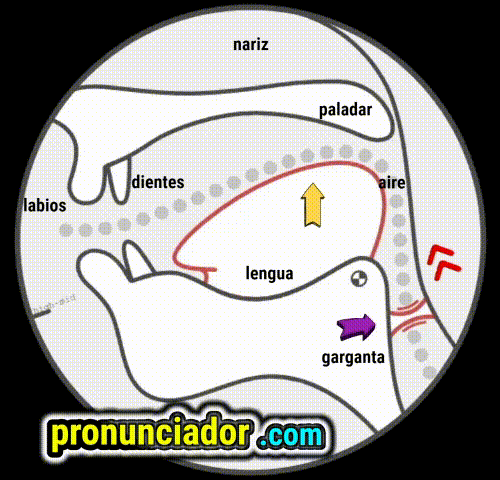
Confusing ‘B’ vs ‘P’? Stop your ‘big’ sounding like ‘pig’. This guide reveals the #1 secret for a voiced /b/ sound: the throat buzz. Master the lip pop, fix mistakes & learn silent B rules for a clearer accent!
Hey American English explorers! Get ready to boost your pronunciation with a sound that’s a true building block of English: the /b/ sound, like in “boy,” “baby,” “job,” or “back”! Its phonetic symbol is simply /b/. Now, you’re likely thinking, “The letter B? I’ve got this! It’s pretty much the same everywhere, right?” Well, hold that thought! While the basic idea of pressing your lips together is similar across many languages, the American English /b/ has some super important features, especially regarding its VOICE and a tiny (or no) puff of air, that can make a HUGE difference to your accent!
What often happens when learners tackle the American /b/?
- The “P” Problem: Sometimes, our /b/ might come out sounding more like a /p/! So, “big” accidentally sounds like “pig,” or “cab” sounds like “cap.” This is usually because we forget to “turn on our voice motor” in our throat!
- The “Mushy Middle B”: In words like “about” or “robot,” does your ‘b’ sound a bit soft or “rubbed,” instead of a clear “pop”? Many languages have a softer ‘b’ sound between vowels. American English usually keeps it a pretty crisp “stop.”
- The “Whisper End B”: That ‘b’ at the end of “job” or “club“—does it lose its voice and sound like a ‘p’? (“clup” for “club”).
- Air Puffs? Who Knew?! Did you know the /b/ sometimes has a tiny puff of air, and sometimes it doesn’t? Confusing, right?
- Silent B Traps! And then there are words like “comb” or “doubt” where the ‘B’ is just taking a silent vacation! Aaah!
It’s totally normal to feel a bit baffled! You want your English to sound clear, confident, and natural, but these little “B” blunders can really stand out.
But today, we’re blowing the lid off the American /b/ sound! This ULTIMATE EASY-PEASY GUIDE will turn you into a /b/ Boss:
- Meet the Buzzing /b/: What IS this “lips-pop-with-VOICE-ON” sound, really?
- The #1 Secret: The THROAT BUZZ! This is how you’ll ALWAYS nail /b/ vs. /p/!
- To Puff or Not To Puff [bʰ]: The super-simple TRUTH about when the American /b/ has a tiny puff of air (and when it’s a clean stop!).
- Mouth Moves for a BOOMING /b/ (Kid-Style!): Easy step-by-step, how to make the /b/ sound perfectly!
- Spelling? Pretty Basic! Usually ‘B’ or ‘BB’.
- Silent B Secrets Revealed! We’ll show you when that ‘B’ goes ninja-silent (comb, debt, subtle…).
- Zap Those “B”-ummers! Fix common mistakes and sound undeniably American!
- “Big Bad Bear” Practice! Awesome drills with super common words (‘be’, ‘but’, ‘about’, ‘job’, ‘big’, ‘baby’) to get your /b/ booming!
Get ready for your “beautiful,” “believe,” “bring,” and “both” to sound bold, clear, and brilliant! Let’s begin!
Unpacking the American /b/ Sound: The “Lips Pop + Voice ON!” Hero!
Let’s properly introduce our star for today: the /b/ sound. It’s a fundamental consonant in American English, appearing in tons of words you use all the time! It belongs to the special group of six Stop Consonants – sounds where we stop the air for a moment and then release it with a little pop.
Its Core Superpowers (Explained Kid-Easy!)
Sound scientists call /b/ a “bilabial, voiced, stop consonant.” Sounds fancy! But here’s what it means for your mouth:
- Bilabial (Lips Stick Together!): “Bi” means two, and “labial” means lips. So, for /b/, you simply press your top and bottom lips together firmly to make a seal. No air can get out for a tiny moment! It’s the exact same lip shape you use for the /p/ sound (“pie”) and the /m/ sound (“my”).
- VOICED (Throat BUZZES ON!): This is THE MOST IMPORTANT superpower of /b/! “Voiced” means your vocal cords (those tiny guitar strings in your throat) are SWITCHED ON and VIBRATING when you make the /b/ sound. If you gently touch your throat while saying “b-b-b-b,” you should feel a buzzing or humming. It’s like a tiny motor is running in there!
- Stop (Air Stops, then POPS Out!): Like popping a tiny bubble! First, your closed lips stop the air completely. Then, when you suddenly open your lips, the air escapes with a little burst or “pop.”
Super-Simple “Bubble Pop” Summary for /b/:
- Gently press your lips together tight, like you’re holding water in your mouth.
- Turn ON the buzz in your throat (feel it!).
- Then, POP your lips open quickly, letting the buzzing air escape with a “buh!”
It’s a quick, voiced “lip explosion”!
The EPIC Battle: /b/ (Buzz Pop) vs. /p/ (Air Pop)
These two sounds are made in the EXACT same way with your lips – they’re both “bilabial stops.”
The ONE and ONLY Difference: THE THROAT BUZZ (Voicing)!
| Feature | /b/ (Boy, Big, Cab) | /p/ (Pay, Pig, Cap) |
| Lips Together? | YES! | YES! |
| Air Stops & Pops? | YES! | YES! |
| THROAT BUZZING? | ON! (VOICED) | OFF! (VOICELESS – just air) |
| Little Air Puff? | Gentle/Slight (if start/stressed) | Strong Puff! (if start/stressed) |
The #1 Mistake Many Learners Make: Not turning ON that throat buzz for /b/, so it sounds like /p/. Or, not turning it OFF for /p/, so /p/ sounds like /b/.
- “Big” /bɪɡ/ accidentally sounds like “Pig” /pɪɡ/.
- “Cab” /kæb/ accidentally sounds like “Cap” /kæp/.
The Magic Fix: The Throat Touch Test! Put your fingers on your throat (your “Adam’s apple” area). - Say “ba-ba-ba.” You SHOULD feel a clear BUZZ/VIBRATION. That’s /b/!
- Say “pa-pa-pa.” You should feel NO BUZZ, just the air popping. That’s /p/!
Practice this until you can switch the “voice motor” on and off easily!
How is the American /b/ Different From ‘B’ or ‘V’ in Some Other Languages?
This is another tricky spot! In American English, the /b/ sound is almost ALWAYS a clear STOP sound. This means your lips press together completely to stop the air, and then they pop open. This happens even when the /b/ is between two vowel sounds, like in “about” or “rabbit.”
In some languages (like Spanish, for example), while the ‘b’ at the beginning of a word IS a stop (like “barco”), the ‘b’ (or ‘v’) between vowels often becomes a softer, “rubbing” sound where the lips get close but don’t fully seal and stop the air. This is a fricative [β] sound, not a stop.
- American English “about”: /əˈbɑʊt/ – lips make a clear /b/ pop.
- Spanish “acabó”: /akaˈβo/ – lips get close but air rubs through for [β].
The Learner Trap: Using that softer, “rubbing” [β] sound for the American /b/ between vowels. It makes the American /b/ sound weak or mushy.
The Fix: For American English, always make sure your lips FULLY CLOSE and then POP open for the /b/ sound, even in the middle of words! Feel that crisp “buh!”
To Puff or Not To Puff? The Subtle Air of an American /b/ [bʰ]
Just like its voiceless twin /p/ (and /t/, /k/), the voiced /b/ (and /d/, /ɡ/) can also have a little puff of air when it’s released – this is called aspiration. BUT there’s a big difference!
- Voiceless Stops (/p, t, k/): Have a STRONG, noticeable puff of air [pʰ, tʰ, kʰ] at the beginning of words or stressed syllables.
- Voiced Stops (/b, d, g/): If they are aspirated, the puff is MUCH GENTLER and SHORTER [bʰ, dʰ, ɡʰ]. It’s a very slight release of air with the voice. For /b/, think of it as a “breathy B” at the start.
The Easy Rules for /b/ Aspiration (Same as for /d/ and /g/):
- Aspirated /b/ [bʰ] (GENTLE Puff): You use a slight puff of air with your voiced /b/…
- A) At the VERY BEGINNING of a word:
- Boy /bɔɪ/ → [bʰɔɪ] (A tiny bit of breathy voice with the ‘b’)
- Big /bɪɡ/ → [bʰɪɡ]
- Back /bæk/ → [bʰæk]
- Be /bi/ → [bʰi]
- B) At the BEGINNING of a STRESSED (Strong) Syllable:
- About /əˈbaʊt/ → /əˈbʰaʊt/ (stress on ’bout’)
- Because /bɪˈkɔz/ → /bɪˈkʰɔz/ (The C is /k/, also asp.) -> The example ‘because’ starts with /b/, and ’cause’ is the stressed syllable. If we were to hyper-correct to emphasize aspiration on B: “Because” / bʰɪˈkɔz/.
- Rebel (verb) /rɪˈbɛl/ → /rɪˈbʰɛl/ (stress on ‘bel’)
- A) At the VERY BEGINNING of a word:
- Unaspirated /b/ [b] (or Unreleased [b̚]) (NO Puff/Clean Pop): You use a /b/ WITHOUT that extra puff (just a clean voiced pop, or even held)…
- A) At the VERY END of a word: This is the “Final Stop Rule.” Lips close for /b/, voice is on, but release is clean with NO extra air puff. Sometimes it’s even “unreleased” [b̚] – lips stay closed briefly. [Video Unaspirated /b/ diagram shows final ‘job’].
- Job /dʒɑb/ → /dʒɑ[b]/ or /dʒɑ[b̚]/
- Cab /kæb/ → /kæ[b]/ or /kæ[b̚]/
- Club /klʌb/ → /klʌ[b]/ or /klʌ[b̚]/
- Tub /tʌb/ → /tʌ[b]/ or /tʌ[b̚]/
- B) When /b/ is part of a consonant cluster and NOT initial in a stressed syllable: For instance, in the middle of a word, like “subject” /səbˈdʒɛkt/, the /b/ before /dʒ/ is usually unaspirated. Or “obtain” /əbˈteɪn/, /b/ before /t/ is unaspirated. This is a more advanced point, for now, focus on initial vs. final.
- (Unlike /p,t,k/, there isn’t a common “S+B” cluster at the start of words where /b/ would be specifically unaspirated due to a preceding /s/ like SP, ST, SK).
- A) At the VERY END of a word: This is the “Final Stop Rule.” Lips close for /b/, voice is on, but release is clean with NO extra air puff. Sometimes it’s even “unreleased” [b̚] – lips stay closed briefly. [Video Unaspirated /b/ diagram shows final ‘job’].
Why is this important?
- The slight aspiration [bʰ] at the start of words/stressed syllables helps the /b/ sound clear and fully voiced, distinguishing it further from a weak /p/.
- Crucially, NOT aspirating the final /b/ (i.e., not adding a puff “job-huh”) and keeping it VOICED is key to not sounding like you’re saying “jop“.
Main Focus for /b/ Aspiration: Make sure your initial /b/’s are nice and buzzy (the slight aspiration will often come naturally with a strong voiced release). For final /b/’s, focus on keeping the VOICE ON and a clean, non-puffy release or even holding the lip closure.
Your Mouth’s “B-Buzz-Pop!” Action: Making /b/ Step-by-Step!
Let’s make sure that /b/ is booming and buzzing correctly!
Step 1: Lips TIGHTLY Sealed! (Like a Drum!)
- Bring your top and bottom lips firmly together. They should create a complete seal so NO air can escape. Think of a gentle but complete closure.
Step 2: Voice Motor ON! (Feel the Throat Buzz!)
- THIS IS THE MAGIC KEY! Before you open your lips, start vibrating your vocal cords. Feel that hum or buzz in your throat. It’s like you’re about to say “mmmm” but with your lips ready to pop. The primary instruction from Sounds American “How to Pronounce” steps states: “Voice: Add your voice by vibrating your vocal cords” which occurs as or slightly before the release.
Step 3: The “Buh!” POP! (Release the Voiced Air!)
- While your throat is still buzzing, suddenly POP your lips open.
- The buzzing air will burst out, creating the /b/ sound! “Buh!”
- Air Puff Check (from Aspiration Rules):
- If it’s at the beginning of a word/stressed syllable (“Boy”): Let a tiny bit of that buzzy air come out with the pop – a GENTLE [bʰ] puff.
- If it’s at the end of a word (“Job“): Release the voiced pop cleanly, with NO extra puff [b], or even just keep lips mostly closed [b̚] stopping the sound right there after the voiced closure.
Kid-Friendly “Bouncing Ball” Summary:
- Press your lips together like you’re holding a tiny, bouncy ball in your mouth.
- Make your throat “hum” or “buzz” like a bee (“zzzz” but with lips closed).
- Then, let the bouncy ball POP out by quickly opening your lips! “Buh! Buh! Buh!” If it’s at the start of a word, let a tiny bit of buzzy air follow the ball!
Feeling the “B” Buzz: Practice holding the lip closure while your voice is ON. You should feel the pressure of voiced air building up. Then release! Contrast “mmmmmmm-BUH!” (voiced) with “ffffffffff-PUH!” (voiceless for /p/, starting with a different continuant to feel voicelessness then lips close).
Spelling the /b/ Sound: Mostly “B” for Basic!
This is mostly good news! The /b/ sound has pretty straightforward spelling.
The Undisputed Hero: Letter ‘B’! (~97%)
Almost every single time you see the letter ‘B’ in a word, it will make our /b/ sound!
- be, boy, big, about, job, club, remember, probably.
The Double Trouble (But Still Single Sound!): ‘BB’! (~3%)
When you see ‘BB’ together, it also just makes ONE single /b/ sound. The double letters often just tell you something about the vowel before them (usually that it’s short).
- Rabbit /ˈræbɪt/
- Håbby /ˈhɑbi/ (note ‘o’ here as /ɑ/)
- Rubber /ˈrʌbər/
- Stubborn /ˈstʌbərn/
- Bubble /ˈbʌbəl/
Main Spelling Takeaway: If you see ‘B’ or ‘BB’, think /b/ sound!
The SILENT ‘B’ – When ‘B’ Is a Ninja (You Don’t Hear It!) 🤫
Aha! But English loves its exceptions! There are some key patterns where a written ‘B’ is COMPLETELY SILENT! You must learn these:
- ‘B’ AFTER ‘M’ at the END of a word (-MB final): The ‘B’ is almost always silent here.
- Comb /koʊm/ (Sounds like “kome”)
- Thumb /θʌm/ (“Thum”)
- Lamb /læm/ (“Lam”)
- Climb /klaɪm/ (“Clime”)
- Dumb /dʌm/ (“Dum”)
- Bomb /bɑm/ (“Bahm”)
- Crumb /krʌm/ (“Crum”)
- Tomb /tum/ (“Toom” – exceptional vowel /u/ here for ‘o’)
- Womb /wum/ (“Woom” – exceptional vowel /u/ here for ‘o’)
- BUT: If ‘-MB-‘ is in the MIDDLE of a word followed by another vowel, the /b/ IS usually pronounced! E.g., “number” /ˈnʌmbər/, “timber” /ˈtɪmbər/, “combination” /ˌkɑmbəˈneɪʃən/.
- ‘B’ BEFORE ‘T’ at the END of the SAME syllable (-BT ending): The ‘B’ is usually silent.
- Debt /dɛt/ (Sounds like “det”)
- Doubt /daʊt/ (Sounds like “dowt”)
- Subtle /ˈsʌtəl/ (or /ˈsʌɾəl/ with Flap T! Sounds like “SUT-uhl” – ‘b’ silent!)
Memorize these common silent ‘B’ situations (-MB ending, -BT ending in “debt,” “doubt,” “subtle”) to avoid sounding them out!
Whoops! Common “B” Blunders & Easy Fixes!
What are the most frequent slip-ups when learners pronounce /b/?
- MISTAKE #1: THE “P” TAKEOVER! (Final /b/ becomes /p/ – Devoicing)
- The Problem: This is HUGE. Your vocal cords stop buzzing too early when /b/ is at the end of a word. “Job” sounds like “jop.” “Club” sounds like “clup.”
- THE #1 FIX: KEEP THE BUZZ GOING! For final /b/, make sure you feel that throat vibration right through the lip closure and slight release. Don’t let the voice “die” before the sound is finished. Practice “caB-B-B,” “joB-B-B,” holding the voiced closure slightly.
- MISTAKE #2: THE “SOFT/MUSHY B”! (Using a Fricative [β] instead of a Stop /b/ between vowels)
- The Glitch: Instead of a clear “pop” from your lips, you let air “rub” through barely closed lips, especially in words like “about” or “rabbit.”
- The Fix: LIPS SEAL & POP! Remember, American /b/ is a STOP. Lips must press together completely to stop the air, then pop open. Even between vowels, make that crisp “buh!”
- MISTAKE #3: NOT ENOUGH “BUZZ” (Insufficient Voicing for Initial /b/)
- Problem: Your initial /b/ sounds weak and might be mistaken for /p/ if the voice isn’t strong enough from the start.
- Solution: PRE-VOICE! Try to start the “hum” in your throat just a micro-second before your lips pop open for the /b/. Think “mmmmmmBUH!” Exaggerate the buzz.
- MISTAKE #4: WRONG AIR PUFF (Aspiration Issues)
- Uh-Oh: Adding a strong puff of air to final /b/ (“job-HUH”) or using a very strong puff on initial /b/ making it sound too much like an aspirated P if voicing is also weak.
- Easy Fix: Initial /b/ only needs a slight, breathy puff WITH the voice [bʰ]. Final /b/ needs NO puff [b]/[b̚], just a clean voiced release or hold. Focus on the VOICING more than the puff for /b/.
- MISTAKE #5: Sounding Out a SILENT ‘B’!
- Problem: Saying “com-BUH” for “comb” or “dou-BUT” for “doubt.”
- Solution: MEMORIZE the silent B patterns! When you see -MB at the end, or -BT in “debt/doubt/subtle,” that B is taking a nap.
“Boom Boom B!” Practice Workout for the American /b/!
Let’s get those lips popping and those vocal cords buzzing!
Exercise 1: The “Throat Buzz” Warm-up – Pure Voicing!
- Place fingers on your throat.
- Close your lips lightly.
- Now, just make a continuous “MMMMMMMM” sound. Feel the strong vibration!
- From that “MMMM,” try to make it build pressure and then POP your lips open while keeping the buzz going: “Mmmmm-BUH! Mmmm-BUH!” That pop IS your /b/!
Exercise 2: The P vs. B Showdown – VOICE ON vs. VOICE OFF! (THE BIG ONE!)
This is your key exercise! Focus on the THROAT VIBRATION for /b/ and NO VIBRATION for /p/.
- Pay [pʰeɪ] (No Buzz, Big Air) — Bay [bʰeɪ] (BUZZ, Slight Air)
- Pin [pʰɪn] (No Buzz, Big Air) — Bin [bʰɪn] (BUZZ, Slight Air)
- Cap [kæp̚] (No Buzz, No Air Puff) — Cab [kæb] (BUZZ, No Air Puff)
- Tap [tæp̚] (No Buzz, No Air Puff) — Tab [tæb] (BUZZ, No Air Puff)
- Popped [pɑpt] (P sound ends this!) — Robbed [rɑbd] (B sound ends this!)
RECORD yourself saying these pairs. Can you HEAR and FEEL the voice difference?
Exercise 3: The “Stop B” Challenge! (No Mushy Fricatives!)
Practice making a clear lip “pop” for /b/ even between vowels. Over-annunciate at first!
- a-BOUT, ra-BBIT, pro-BA-BLY, ha-BIT, ro-BOT, no-BODY.
- (Make sure your lips fully close and then burst open with voice for each /b/!)
Exercise 4: Final /b/ Power – Keep it Buzzing!
Focus on making that final /b/ voiced and clean (no big puff).
- Job, club, cab, tub, rub, describe, subscribe, globe, robe.
- (Say “cluBBB” and then shorten the end, keeping the buzz in the “B” stop).
Exercise 5: Silent B Ninja Training! (Don’t Say It!)
Read these, remembering the B is invisible to your mouth!
- Comb (kome), Thumb (thum), Lamb (lam), Climb (clime), Dumb (dum), Bomb (bahm).
- Debt (det), Doubt (dowt), Subtle (SUT-uhl, t may be flap).
Exercise 6: Official Top 30 Workout!
| PHONETICAL PRONUNCIATION |
| PHONETICAL PRONUNCIATION |
- Is the /b/ initial/stressed (gentle aspiration [bʰ] likely)?
- Is the /b/ final (unaspirated [b]/[b̚], but VOICED)?
- Is it a ‘BB’ (single /b/ sound)?
RECORD and critique your voicing and aspiration!
Exercise 7: “Big Brown Bears Buy Blueberries!” – /b/ Sentences!
Time to put it into full sentences! RECORD and listen for clear, voiced, popping /b/’s!
- “Big [bʰ] brown [bʰ] bears buy [bʰ] big [bʰ] blue [bʰ] berries!” (Lots of initial /b/!)
- “Rob put the club [b] in the cab [b] with Bob [b].” (Lots of final /b/ – keep them voiced!)
- “The baby [bʰ] [b] wants a bath tub [b] and a bib [b].” (Medial and final /b/.)
- “Probably [pʰ][b][b] the best [bʰ] books [bʰ] are about [bʰ] baseball [bʰ].” (B vs P contrast too!)
FAQs: Your American /b/ Sound (“Boy”) Questions Answered!
Q1: What’s the ABSOLUTE #1 trick to make my English “B” sound right and not like “P”?
VOICE! VOICE! VOICE! Your vocal cords MUST be vibrating (buzzing in your throat) when you make the /b/ sound. For /p/, they are OFF (no buzz). Put your hand on your throat to feel the difference. If your “B” has no buzz, it will sound like “P.”
Q2: Does the American /b/ have a puff of air (aspiration) like /p/ does?
Yes, but it’s GENTLER and SOFTER than for /p/.
- A slight puff of voiced air [bʰ] usually happens when /b/ is at the beginning of a word (“boy”) or starts a stressed syllable (“about”).
- There’s NO PUFF (or it’s unreleased [b̚]) when /b/ is at the end of a word (“job“).
Don’t overdo the puff for /b/; focus more on the voicing.
Q3: How is the American /b/ in “about” or “baby” different from how I might say ‘b’ between vowels in my native language (e.g., Spanish)?
In American English, the /b/ (even between vowels like in “about” or “baby”) is almost always a full STOP consonant. This means your lips press together completely to stop the airflow for a moment, then they pop open. In some languages, like Spanish, ‘b’ or ‘v’ between vowels can become a softer, “rubbing” sound [β] where the lips get close but don’t fully stop the air. For American English /b/, always aim for that clear “lip pop.”
Q4: When is the letter ‘B’ SILENT in English words?
There are two main times the ‘B’ is a ninja and doesn’t make a sound:
- After ‘M’ at the very END of a word: comb (/koʊm/), thumb (/θʌm/), lamb (/læm/), climb (/klaɪm/).
- Before ‘T’ at the END of the same syllable (in a few specific words): debt (/dɛt/), doubt (/daʊt/), subtle (/ˈsʌtəl/).
Memorize these!
Q5: Does “BB” (double B) make a longer or stronger /b/ sound?
Nope! ‘BB’ (like in “rabbit” or “hobby”) just makes one regular /b/ sound. The double letter is a spelling thing, often to show the vowel before it is short. Don’t try to make two ‘b’ sounds or a longer one.
Wrapping Up: Your “Brilliant” American /b/ Awaits!
You’ve done brilliantly! The American /b/ sound, with its essential VOICE and its “pop,” is now within your grasp. You know it’s not just a “B,” it’s a voiced bilabial stop that needs a different touch than its voiceless twin /p/, and often a different touch than the ‘B’ in your native language.
Your “B”-rilliant Takeaways:
- /b/ = LIPS TOGETHER + THROAT BUZZ ON + POP! (Voiced Bilabial Stop).
- VS. /P/ = BUZZ ON for /b/, BUZZ OFF for /p/! This is #1.
- ASPIRATION (AIR PUFF): Slight gentle puff [bʰ] at start of words/stressed syllables. NO puff [b]/[b̚] at word ends (but keep it voiced!).
- ALWAYS A STOP! Lips fully close and pop, even between vowels (no “mushy” /b/ like [β]).
- SPELLING: Mostly ‘B’ or ‘BB’.
- SILENT ‘B’: Remember -MB ends (comb) and -BT ends (debt).
The key is that consistent throat buzz and the crisp lip pop. Keep practicing with minimal pairs (/p/ vs /b/), record yourself, and really listen to native speakers. Your “big,” “job,” “about,” and “baby” will soon be bursting with authentic American energy! Good luck, and be bold with your /b/!
👇🔥👇🔥👇🔥👇🔥👇🔥👇🔥
👉 RETURNS in the YEAR 2031 ! WHO? CLICK HERE ! 🔥
Dictionary & Pronunciation translator for english speakers (US,UK)
👇🔥👇🔥👇🔥👇🔥👇🔥👇🔥
Diccionario y Traductor de Pronunciación para hispanohablantes (español)
Phonetic Pronunciation Dictionary
Ready to improve?
Enter an English word above to see its detailed pronunciation and video examples.
Finding pronunciation...
👉 RETURNS in the YEAR 2031 ! WHO? CLICK HERE ! 🔥
👇🔥👇🔥👇🔥👇🔥👇🔥👇🔥
Spanish Pronunciation Guide
Instant, easy-to-pronounce translation into Spanish for English speakers.
👇🔥👇🔥👇🔥👇🔥👇🔥👇🔥
👉 RETURNS in the YEAR 2031 ! WHO? CLICK HERE ! 🔥
👇🔥👇🔥👇🔥👇🔥👇🔥👇🔥
¿Cómo se pronuncian los números y letras del abecedario | alfabeto en inglés? descubrelo aqui:
👇🔥👇🔥👇🔥👇🔥👇🔥👇🔥
👉 ¡ REGRESA EN EL AÑO 2031 ! ¿QUIEN? ENTERATE AQUI ! 🔥
👉 ¡ REGRESA EN EL AÑO 2031 ! ¿QUIEN? ENTERATE AQUI ! 🔥
👇🔥👇🔥👇🔥👇🔥👇🔥👇🔥
👉 RETURNS in the YEAR 2031 ! WHO? CLICK HERE ! 🔥
👉 RETURNS in the YEAR 2031 ! WHO? CLICK HERE ! 🔥
👉 RETURNS in the YEAR 2031 ! WHO? CLICK HERE ! 🔥












